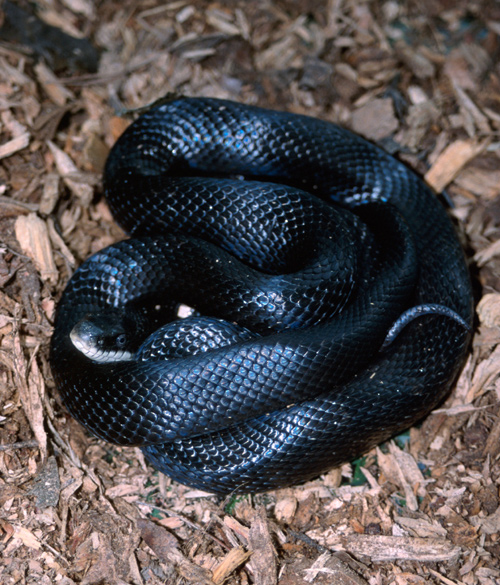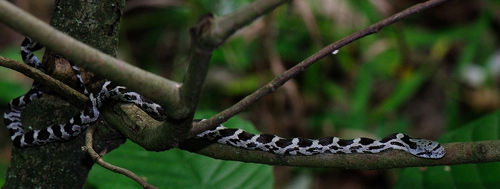The eastern rat snake is a large thick-bodied snake with a solid black body. They are often flecked with white or have traces of white bands. Their chins are white and they have a black and white checkerboard belly. A cross-section of their body would be square. Their head is large and defined by a thinner neck in comparison to their body. The scales are rough so the snake is not glossy like the racer. Eastern rat snakes are Connecticut's longest snake and can be 46 to 68 inches long.
These snakes do not begin their lives as black snakes. Juvenile Eastern rat snakes have a grey and black pattern which deepens to a more solid black as they age.
The range of the eastern rat snake in the US is from southern Vermont to the North Carolina coast, southwest to central Georgia, north to south-central Illinois, south to northern Louisiana and Oklahoma, and north to southwest Minnesota and southern Michigan. Eastern rat snakes have an irregular distribution in Connecticut and can be found in southern Connecticut and in the central region to the northern border. With less farming in the state over the last century or so, the reforestation of much of Connecticut has benefited their population.
Eastern rat snake habitat includes rough forested areas with ledges and rocks and small clearings near woods. They can be found in old barns or attics where they hunt rodents. They can climb and may be found in trees.
Mating season is around May in New England. In July or August females will lay 5 to 54 eggs in soil, decaying wood, or in piles of sawdust or manure. She does not care for her eggs, but leaves them where she lays them. The baby snakes use a special "egg tooth" to hatch out of their eggs in the fall. The young are light gray with dark blotches, a large head, and checkerboard bellies.
Eastern rat snakes are out during the daytime but can be active at night sometimes. They hibernate in the winter beginning about October and emerge in spring. Dens in rock crevices or old burrows are generally used, and eastern ratsnakes often den communally. They can share winter dens with other ratsnakes or with other snake species such as rattlesnakes and black racers. They will often use the same den for years.
Eastern ratsnakes are active hunters and eat insects, frogs, toads, small birds and small mammals. It is estimated that about 60% of their diet consists of small mammals and this is the source of their common name. These snakes can climb trees pretty well and can climb up to about 40 feet. They will eat eggs from nests, swallowing them whole and breaking them in their throat. They will sometimes enter old buildings or attics in their search for rodents. These snakes kill prey by constriction. They wrap an animal in their coils and squeeze until the animal suffocates. They then swallow their meal whole.
Eastern ratsnakes do not want to interact with humans. They will often freeze motionless and hope they go unseen when approached. They can vibrate their tails when alarmed to make a rustling sound in leaves, and they will bite if cornered or handled. However they are relatively gentle snakes. They are not venomous.
To avoid bites, don't bother or approach snakes, and watch where you step. If you see a dangerous snake, move away slowly. They want nothing more than to be left alone.
The eastern ratsnake is often confused with the northern black racer.

